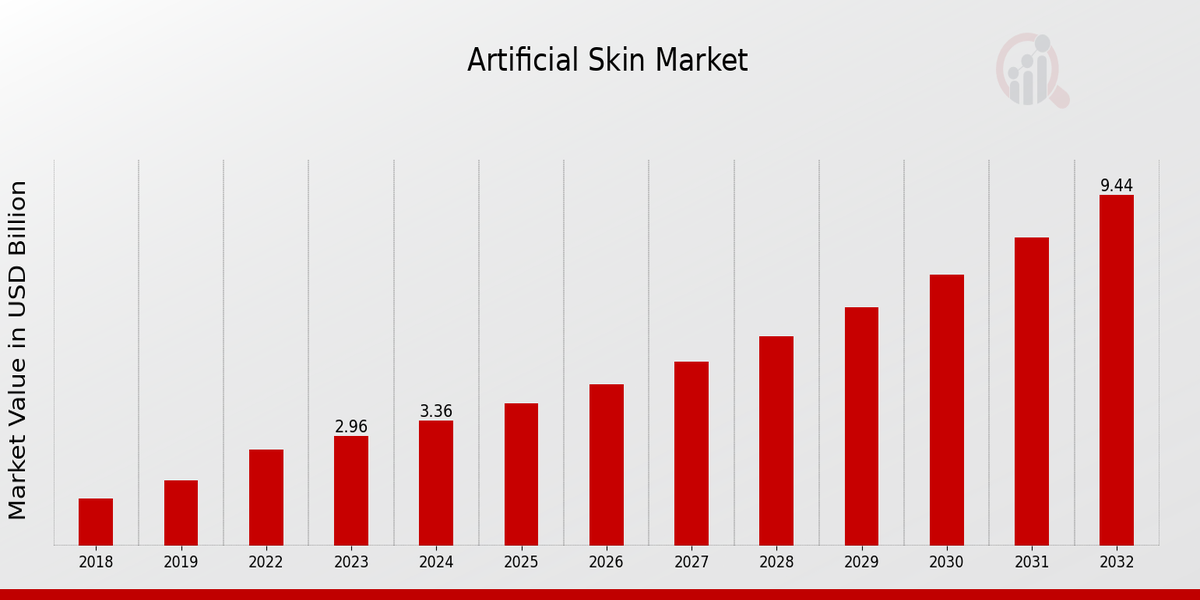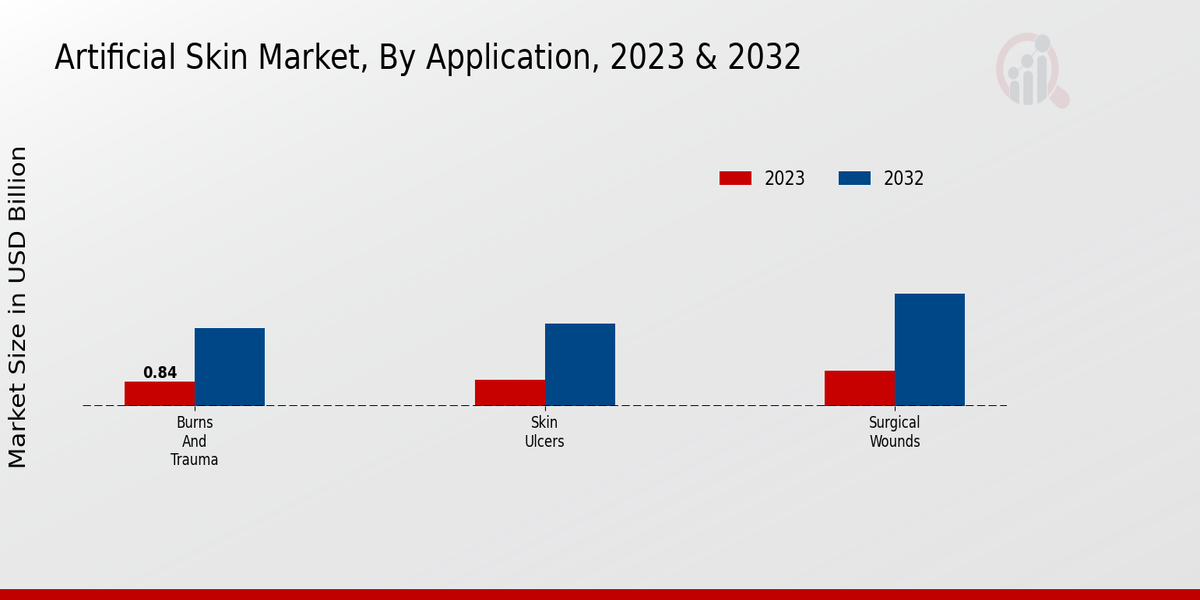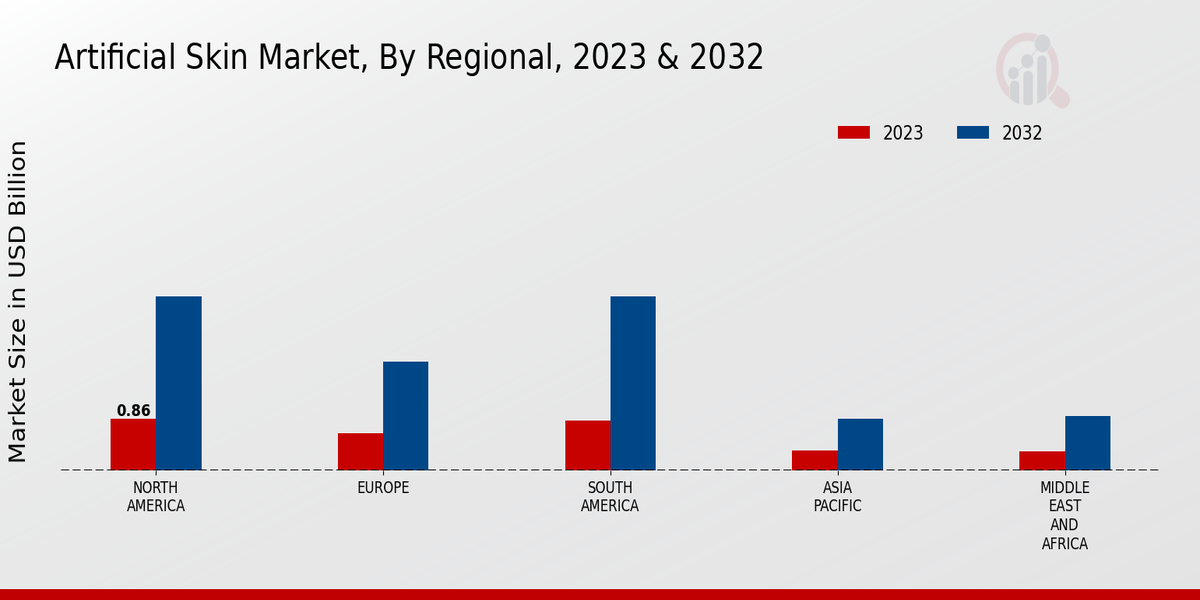Artificial Skin Market Overview
As per MRFR analysis, the Artificial Skin Market Size was estimated at 2.84 (USD Billion) in 2023. The Artificial Skin Market Industry is expected to grow from 3.07 (USD Billion) in 2024 to 5.32 (USD Billion) by 2032. The Market CAGR (growth rate) is expected to be around 6.29% during the forecast period (2024 - 2032).
Key Artificial Skin Market Trends Highlighted
The increasing prevalence of chronic wounds, such as diabetic ulcers, pressure sores, and burns, is driving the demand for artificial skin. Innovations in tissue engineering and advancements in biomaterials have led to the development of highly functional artificial skin products that can promote wound healing and improve patient outcomes. Moreover, the rising awareness of advanced wound care techniques and the growing adoption of artificial skin in various surgical procedures are contributing to market growth.Opportunities for exploration include the development of personalized artificial skin products tailored to specific patient needs, as well as the integration of artificial intelligence and machine learning to enhance wound care. Additionally, collaborations between researchers, healthcare providers, and industry players can foster further advancements in the field. Recent trends indicate a shift towards bioengineered and biodegradable artificial skin, offering improved biocompatibility and reduced risk of rejection. Furthermore, the use of artificial skin in cosmetic and reconstructive surgeries is expanding, creating new avenues for market growth.

Source: Primary Research, Secondary Research, MRFR Database and Analyst Review
Artificial Skin Market Drivers
Increasing Prevalence of Chronic Wounds
Diabetic foot ulcers, pressure sores, and venous leg ulcers, among others, constitute a large problem of global healthcare for chronic wounds. The increased prevalence of the problem can be explained by the continuous growth of the aging population and, consequently, the increasing number of people with diabetes, vascular disorders, and overweight, as well as the sedentary lifestyle of the population. Chronic wounds require long and complex treatment that leads to a significant financial burden on healthcare systems.Increasing opportunities to make this treatment less time-consuming and invasive to the patient’s time create new demand for artificial skin. In effect, the Artificial Skin Market is anticipated to grow over the coming years due to the growing demand for effective wound care.
Advancements in Tissue Engineering and Regenerative Medicine
Recent advances in the field of tissue engineering and regenerative medicine have led to the development of novel artificial skin products. Such solutions are engineered to replicate the anatomy and physiology of human skin and improve wound healing outcomes. Today, researchers apply stem cells, biomaterials, and growth factors to construct artificial skin that could serve as a substitute for damaged or lost tissues. In the future, these regenerative medicine solutions will be incorporated into artificial skin products to increase their effectiveness and promote their use in a variety of clinical applications.
Technological Advancements and Innovation
While the Artificial Skin Market Industry is constantly changing, technological innovation and research and development by companies significantly drive the industry. The materials of artificial skins are also evolving and new types and forms of biocompatible and biodegradable materials have been introduced in the recent past. Companies are also working to manufacture artificial skins that are integrated with sensors to monitor the state of a wound in real-time.
Artificial Skin Market Segment Insights
Artificial Skin Market Application Insights
The Artificial Skin Market is segmented based on application into burns and trauma, skin ulcers, and surgical wounds. Among these, the burns and trauma segment held the largest market share in 2023, and it is expected to continue its dominance during the forecast period. This growth is attributed to the rising incidence of burns and trauma cases worldwide. According to the World Health Organization (WHO), approximately 180,000 people die each year due to burns, while millions more suffer from non-fatal burns. The skin ulcers segment is expected to witness significant growth during the forecast period.This growth is attributed to the increasing prevalence of chronic diseases such as diabetes and venous insufficiency, which can lead to the development of skin ulcers. The surgical wounds segment is also expected to grow steadily during the forecast period. This growth is attributed to the increasing demand for artificial skin in various applications, such as burns and trauma, skin ulcers, and surgical wounds.

Source: Primary Research, Secondary Research, MRFR Database and Analyst Review
Artificial Skin Market Product Type Insights
Overview Collagen-based artificial skin, gel-based artificial skin, and bioengineered artificial skin are the key product types in the Artificial Skin Market. Collagen-based artificial skin accounted for the largest market share in 2023 and is expected to be the largest segment during the forecast period. The biocompatibility, low immunogenicity, and ability to promote cell adhesion of collagen-based skin make it ideal for a broad range of applications, including wound healing, burns, and skin grafting. The gel-based artificial skin, having a high-water content and the ability to mold to irregular surfaces, is primarily used for wound care and burns.Bioengineered artificial skin uses cells and scaffolds to produce living skin substitutes, which may serve as potential advancements in skin regeneration and repair. Owing to the potential application of bioengineered artificial skin to treat complex wounds and skin defects, this segment is expected to exhibit the highest growth during the forecast period. The Artificial Skin Market revenue from collagen-based artificial skin is projected to be USD 2.45 billion by 2024, while gel-based artificial skin and bioengineered artificial skin are anticipated to reach USD 1.32 billion and USD 0.97 billion, respectively.
Artificial Skin Market Material Insights
The Artificial Skin Market is segmented based on Material into Synthetic Materials and Natural Materials. Synthetic Materials accounted for the largest market share in 2023 and is expected to continue its dominance during the forecast period. The growth of this segment can be attributed to the increasing use of synthetic materials such as polyurethane, silicone, and polyester in the production of artificial skin due to their biocompatibility, flexibility, and durability. Natural Materials, on the other hand, are expected to witness a steady growth rate during the forecast period due to the rising demand for bio-based and sustainable products.
Artificial Skin Market End User Insights
The Artificial Skin Market segmentation by End User is broadly classified into Hospitals and Clinics, Burn Centers, and Plastic Surgery Centers. Hospitals and Clinics accounted for the largest market share in 2023, owing to the rising prevalence of burn injuries and the increasing adoption of advanced wound care techniques in hospitals. Burn Centers are expected to witness a significant growth rate during the forecast period due to the increasing number of burn cases and the growing focus on specialized burn care facilities. Plastic Surgery Centers are also projected to contribute to the growth of the market, driven by the growing demand for cosmetic and reconstructive surgeries.The Artificial Skin Market revenue generated from the End User segment is expected to reach USD 3.48 billion by 2024, exhibiting a CAGR of 14.2% during the forecast period.
Artificial Skin Market Regional Insights
The regional segmentation of the Artificial Skin Market offers valuable insights into the market's geographic distribution and growth dynamics. North America is projected to dominate the market, accounting for a significant share of the Artificial Skin Market revenue in 2024 and beyond. The region's well-established healthcare infrastructure, high prevalence of chronic wounds, and increasing adoption of advanced wound care technologies drive its market growth. Europe follows closely behind North America, with a substantial market share.The presence of a large geriatric population, rising healthcare expenditure, and government initiatives supporting wound care innovation contribute to the region's growth. APAC is expected to witness the fastest growth rate during the forecast period. Increasing awareness of wound care management, expanding healthcare access, and rising disposable income in developing countries fuel the region's market expansion. South America and MEA also hold promising growth potential due to the growing incidence of chronic wounds and the increasing demand for advanced wound care solutions.These regional insights are crucial for market players to identify target markets, optimize distribution channels, and tailor their strategies to specific regional dynamics.

Source: Primary Research, Secondary Research, MRFR Database and Analyst Review
Artificial Skin Market Key Players And Competitive Insights
Major players in the Artificial Skin Market industry are continuously engaged in research and development activities to enhance their product offerings and gain a competitive edge. Leading Artificial Skin Market players are investing heavily in developing advanced artificial skin products with improved functionality and biocompatibility. They are also expanding their production capacities to meet the growing demand for artificial skin in various applications. The Artificial Skin Market development landscape is characterized by collaborations and partnerships between industry players to leverage complementary strengths and accelerate innovation.Among the leading Artificial Skin Market players, Integra LifeSciences is a prominent company. Integra LifeSciences focuses on providing innovative medical solutions for tissue regeneration and repair.
The company's artificial skin products include Integra Dermal Regeneration Template (DRT) and Integra Omnia, which are used in various applications such as reconstructive surgery, burn treatment, and wound healing. Integra LifeSciences has a global presence and distributes its products in over 100 countries. The company's commitment to research and development has resulted in a strong portfolio of intellectual property, including patents and trademarks.Another notable competitor in the Artificial Skin Market is MiMedx Group. MiMedx Group specializes in developing and marketing regenerative biomaterials for various medical applications. The company's artificial skin product, EpiFix, is a human-derived biomaterial used in the treatment of diabetic foot ulcers, venous leg ulcers, and pressure ulcers. MiMedx Group has a strong focus on clinical research and has conducted numerous clinical trials to demonstrate the efficacy and safety of its products. The company's distribution network spans over 40 countries, enabling it to reach a wide range of healthcare providers and patients.
Key Companies in the Artificial Skin Market Include
- Advanced Tissue Sciences, Inc.
- Nuvasive Inc.
- Braun Melsungen AG
- Stryker
- Organogenesis
- Johnson Johnson
- Convatec Group PLC
- Medtronic
- Allergan
- Wright Medical Group N.V
- MiMedX Group, Inc.
- Coloplast Corp
- Vericel Corporation
- Smith Nephew
- Integra Lifesciences Corporation
Artificial Skin Market Industry Developments
The Artificial Skin Market is projected to reach USD 5.32 billion by 2032, exhibiting a CAGR of 6.29% during the forecast period (2024-2032). The rising prevalence of chronic wounds, increasing demand for advanced wound care products, and growing awareness about artificial skin are key factors driving the market growth. Technological advancements, such as the development of bioengineered skin substitutes and 3D printing techniques, are further fueling market expansion. Key industry participants include Organogenesis, MiMedx Group, Integra LifeSciences, and Smith Nephew. Strategic collaborations, acquisitions, and product launches are shaping the competitive landscape. Recent developments include the FDA approval of Avita Medical's ReCell System for the treatment of burns and the launch of Organogenesis' NovoSorb Bioengineered Tissue for wound healing.
Artificial Skin Market Segmentation Insights:
Artificial Skin Market Application Outlook
- Burns and Trauma
- Skin Ulcers
- Surgical Wounds
Artificial Skin Market Product Type Outlook
- Collagen-Based Artificial Skin
- Gel-Based Artificial Skin
- Bioengineered Artificial Skin
Artificial Skin Market Material Outlook
- Synthetic Materials
- Natural Materials
Artificial Skin Market End User Outlook
- Hospitals and Clinics
- Burn Centers
- Plastic Surgery Centers
Artificial Skin Market Regional Outlook
- North America
- Europe
- South America
- Asia Pacific
- Middle East and Africa
| Report Attribute/Metric |
Details |
| Market Size 2023 |
2.84 (USD Billion) |
| Market Size 2024 |
3.07(USD Billion) |
| Market Size 2032 |
5.32 (USD Billion) |
| Compound Annual Growth Rate (CAGR) |
6.29% (2024 - 2032) |
| Report Coverage |
Revenue Forecast, Competitive Landscape, Growth Factors, and Trends |
| Base Year |
2023 |
| Market Forecast Period |
2024 - 2032 |
| Historical Data |
2019 - 2023 |
| Market Forecast Units |
USD Billion |
| Key Companies Profiled |
Advanced Tissue Sciences, Inc., Nuvasive Inc., B. Braun Melsungen AG, Stryker, Organogenesis, Johnson Johnson, Convatec Group PLC, Medtronic, Allergan, Wright Medical Group N.V, MiMedX Group, Inc., Coloplast Corp, Vericel Corporation, Smith Nephew, Integra Lifesciences Corporation |
| Segments Covered |
Application, Product Type, Material, End User, Regional |
| Key Market Opportunities |
3D Bioprinting Burn Treatment Advancements Chronic Wound Management Tissue Engineering Cosmetic Applications |
| Key Market Dynamics |
Increasing demand for regenerative medicine Rising prevalence of burns and chronic wounds Advancements in tissue engineering Technological innovations in biomaterials Government initiatives and funding |
| Countries Covered |
North America, Europe, APAC, South America, MEA |
Frequently Asked Questions (FAQ) :
The Artificial Skin Market is expected to reach an overall valuation of 3.07 Billion USD in 2024, showcasing significant growth potential.
The Artificial Skin Market is projected to grow at a robust CAGR of 6.29% during the period from 2024 to 2032, indicating a promising growth trajectory.
North America is anticipated to dominate the Artificial Skin Market in 2023, capturing a significant market share due to factors such as advanced healthcare infrastructure and a high prevalence of chronic wounds.
Artificial Skin finds extensive applications in various healthcare domains, including the treatment of burns, diabetic foot ulcers, and other chronic wounds. It serves as a temporary or permanent replacement for damaged skin, promoting wound healing and reducing the risk of infection.
Key competitors in the Artificial Skin Market include Integra LifeSciences, MiMedx Group, Organogenesis, and Stratatech. These companies are actively involved in research and development, product innovation, and strategic collaborations to maintain their market presence.
The increasing prevalence of chronic wounds, advancements in tissue engineering techniques, and growing awareness about the benefits of Artificial Skin contribute to the market's growth. Additionally, government initiatives and funding for research and development further stimulate market expansion.
Challenges in the Artificial Skin Market include regulatory hurdles, reimbursement issues, and the need for skilled professionals for proper application and monitoring. Moreover, concerns regarding potential complications and the development of alternative wound care solutions may pose challenges to market growth.
Emerging trends in the Artificial Skin Market involve the development of advanced biomaterials, personalized medicine approaches, and the integration of Artificial Skin with other technologies. Additionally, research focuses on improving skin regeneration capabilities and reducing the risk of infection and scarring.
The Artificial Skin Market is projected to reach a substantial valuation of 5.32 Billion USD by 2032, reflecting the increasing demand for effective wound care solutions and technological advancements in the field.
Artificial Skin has the potential to revolutionize wound care management and improve patient outcomes. It offers numerous advantages, such as reduced healing time, minimized scarring, and enhanced protection against infection. As research continues, Artificial Skin may find even broader applications in regenerative medicine and tissue engineering.

















